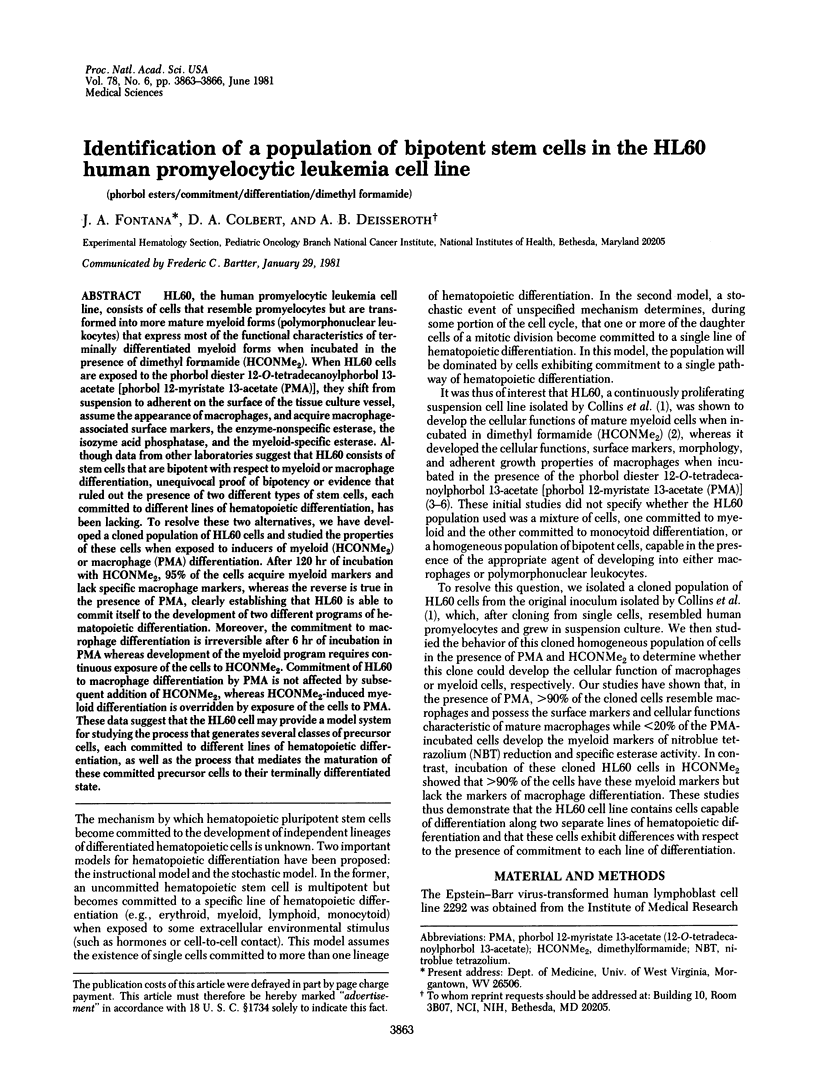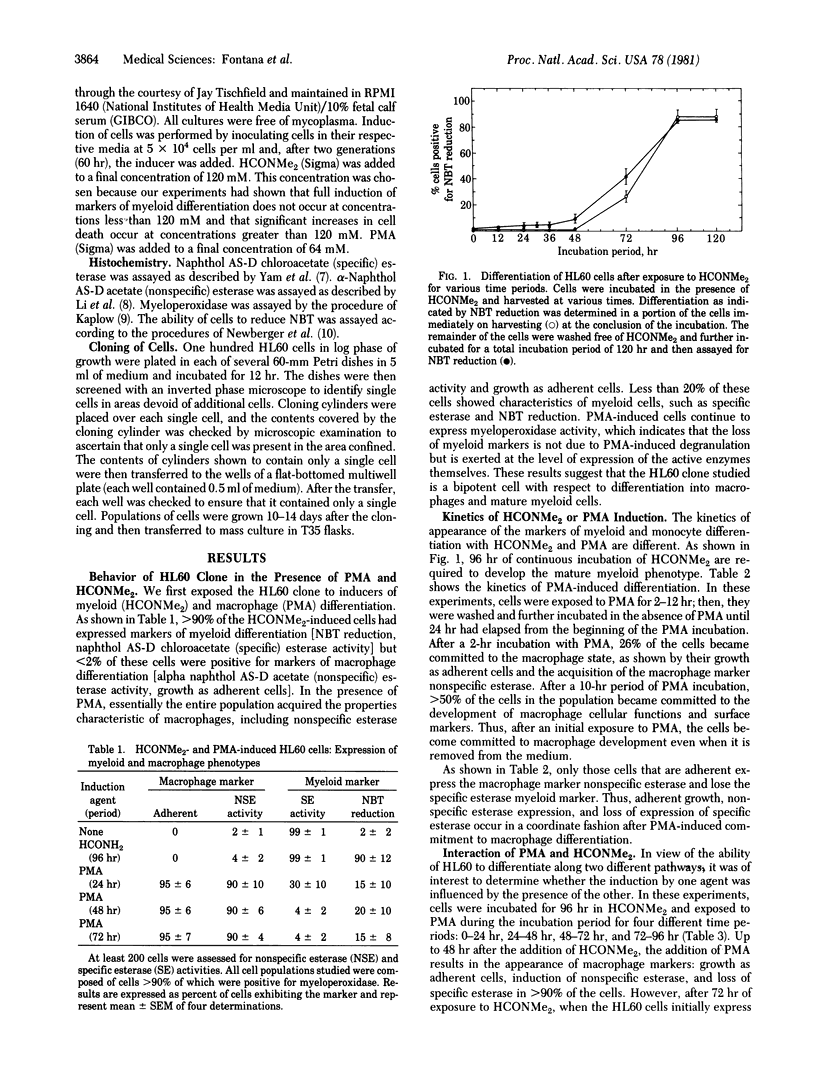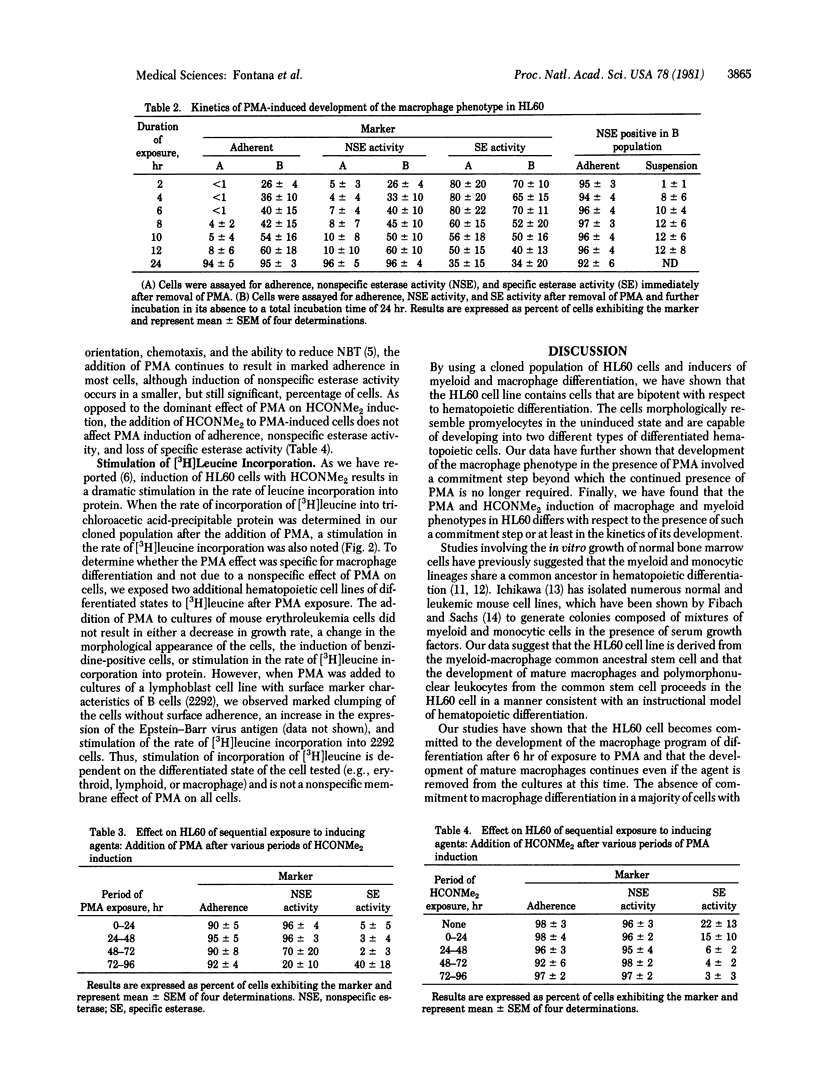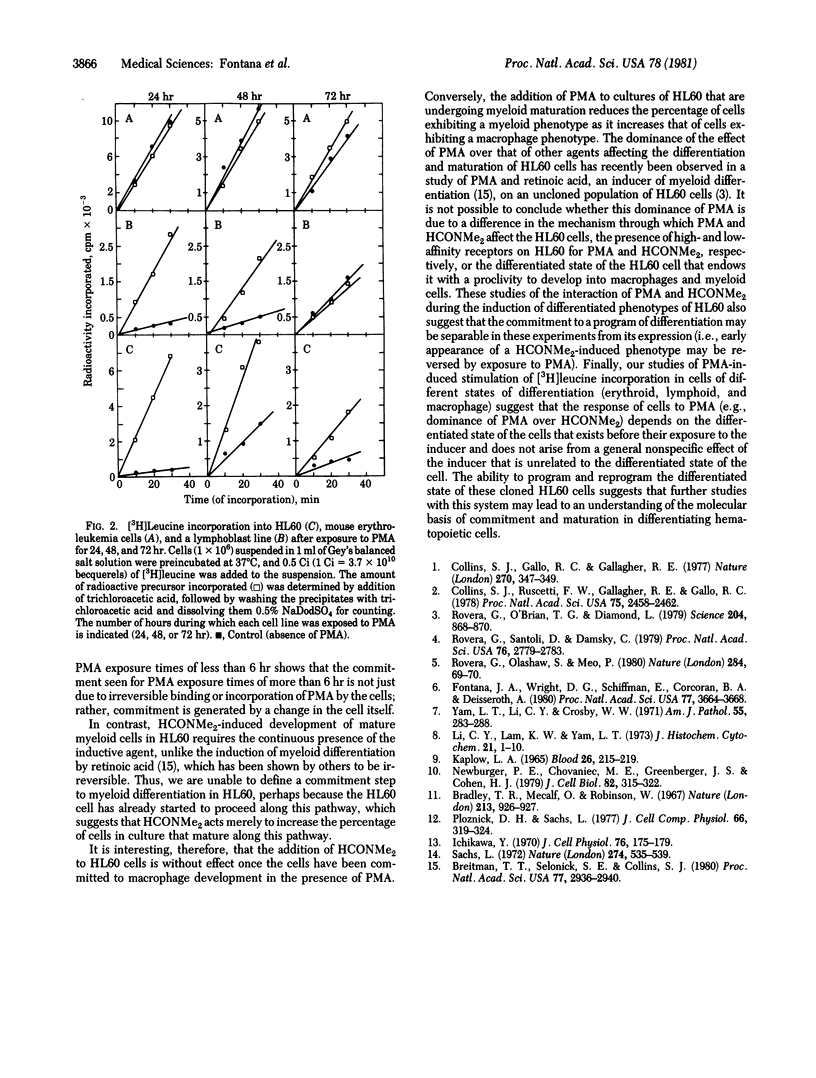Abstract
HL60, the human promyelocytic leukemia cell line, consists of cells that resemble promyelocytes but are transformed into more mature myeloid forms (polymorphonuclear leukocytes) that express most of the functional characteristics of terminally differentiated myeloid forms when incubated in the presence of dimethyl formamide (HCONMe2). When HL60 cells are exposed to the phorbol diester 12-O-tetradecanoylphorbol 13-acetate [phorbol 12-myristate 13-acetate (PMA)], they shift from suspension to adherent on the surface of the tissue culture vessel, assume the appearance of macrophages, and acquire macrophage-associated surface markers, the enzyme-nonspecific esterase, the isozyme acid phosphatase, and the myeloid-specific esterase. Although data from other laboratories suggest that HL60 consists of stem cells that are bipotent with respect to myeloid or macrophage differentiation, unequivocal proof of bipotency or evidence that ruled out the presence of two different types of stem cells, each committed to different lines of hematopoietic differentiation, has been lacking. To resolve these two alternatives, we have developed a cloned population of HL60 cells and studied the properties of these cells when exposed to inducers of myeloid (HCONMe2) or macrophage (PMA) differentiation. After 120 hr of incubation with HCONMe2, 95% of the cells acquire myeloid markers and lack specific macrophage markers, whereas the reverse is true in the presence of PMA, clearly establishing that HL60 is able to commit itself to the development of two different programs of hematopoietic differentiation. Moreover, the commitment to macrophage differentiation is irreversible after 6 hr of incubation in PMA whereas development of the myeloid program requires continuous exposure of the cells to HCONMe2. Commitment of HL60 to macrophage differentiation by PMA is not affected by subsequent addition of HCONMe2, whereas HCONMe2-induced myeloid differentiation is overridden by exposure of the cells to PMA. These data suggest that the HL60 cell may provide a model system for studying the process that generates several classes of precursor cells, each committed to different lines of hematopoietic differentiation, as well as the process that mediates the maturation of these committed precursor cells to their terminally differentiated state.
Keywords: phorbol esters, commitment, differentiation, dimethyl formamide
Full text
PDF



Selected References
These references are in PubMed. This may not be the complete list of references from this article.
- Bradley T. R., Metcalf D., Robinson W. Stimulation by leukaemic sera of colony formation in solid agar cultures by proliferation of mouse bone marrow cells. Nature. 1967 Mar 4;213(5079):926–927. doi: 10.1038/213926a0. [DOI] [PubMed] [Google Scholar]
- Breitman T. R., Selonick S. E., Collins S. J. Induction of differentiation of the human promyelocytic leukemia cell line (HL-60) by retinoic acid. Proc Natl Acad Sci U S A. 1980 May;77(5):2936–2940. doi: 10.1073/pnas.77.5.2936. [DOI] [PMC free article] [PubMed] [Google Scholar]
- Collins S. J., Gallo R. C., Gallagher R. E. Continuous growth and differentiation of human myeloid leukaemic cells in suspension culture. Nature. 1977 Nov 24;270(5635):347–349. doi: 10.1038/270347a0. [DOI] [PubMed] [Google Scholar]
- Collins S. J., Ruscetti F. W., Gallagher R. E., Gallo R. C. Terminal differentiation of human promyelocytic leukemia cells induced by dimethyl sulfoxide and other polar compounds. Proc Natl Acad Sci U S A. 1978 May;75(5):2458–2462. doi: 10.1073/pnas.75.5.2458. [DOI] [PMC free article] [PubMed] [Google Scholar]
- Fontana J. A., Wright D. G., Schiffman E., Corcoran B. A., Deisseroth A. B. Development of chemotactic responsiveness in myeloid precursor cells: studies with a human leukemia cell line. Proc Natl Acad Sci U S A. 1980 Jun;77(6):3664–3668. doi: 10.1073/pnas.77.6.3664. [DOI] [PMC free article] [PubMed] [Google Scholar]
- Ichikawa Y. Further studies on the differentiation of a cell line of myeloid leukemia. J Cell Physiol. 1970 Oct;76(2):175–184. doi: 10.1002/jcp.1040760207. [DOI] [PubMed] [Google Scholar]
- KAPLOW L. S. SIMPLIFIED MYELOPEROXIDASE STAIN USING BENZIDINE DIHYDROCHLORIDE. Blood. 1965 Aug;26:215–219. [PubMed] [Google Scholar]
- Li C. Y., Lam K. W., Yam L. T. Esterases in human leukocytes. J Histochem Cytochem. 1973 Jan;21(1):1–12. doi: 10.1177/21.1.1. [DOI] [PubMed] [Google Scholar]
- Newburger P. E., Chovaniec M. E., Greenberger J. S., Cohen H. J. Functional changes in human leukemic cell line HL-60. A model for myeloid differentiation. J Cell Biol. 1979 Aug;82(2):315–322. doi: 10.1083/jcb.82.2.315. [DOI] [PMC free article] [PubMed] [Google Scholar]
- Pluznik D. H., Sachs L. The cloning of normal "mast" cells in tissue culture. J Cell Physiol. 1965 Dec;66(3):319–324. doi: 10.1002/jcp.1030660309. [DOI] [PubMed] [Google Scholar]
- Rovera G., O'Brien T. G., Diamond L. Induction of differentiation in human promyelocytic leukemia cells by tumor promoters. Science. 1979 May 25;204(4395):868–870. doi: 10.1126/science.286421. [DOI] [PubMed] [Google Scholar]
- Rovera G., Olashaw N., Meo P. Terminal differentiation in human promyelocytic leukaemic cells in the absence of DNA synthesis. Nature. 1980 Mar 6;284(5751):69–70. doi: 10.1038/284069a0. [DOI] [PubMed] [Google Scholar]
- Rovera G., Santoli D., Damsky C. Human promyelocytic leukemia cells in culture differentiate into macrophage-like cells when treated with a phorbol diester. Proc Natl Acad Sci U S A. 1979 Jun;76(6):2779–2783. doi: 10.1073/pnas.76.6.2779. [DOI] [PMC free article] [PubMed] [Google Scholar]
- Sachs L. Control of normal cell differentiation and the phenotypic reversion of malignancy in myeloid leukaemia. Nature. 1978 Aug 10;274(5671):535–539. doi: 10.1038/274535a0. [DOI] [PubMed] [Google Scholar]
- Yam L. T., Li C. Y., Crosby W. H. Cytochemical identification of monocytes and granulocytes. Am J Clin Pathol. 1971 Mar;55(3):283–290. doi: 10.1093/ajcp/55.3.283. [DOI] [PubMed] [Google Scholar]


